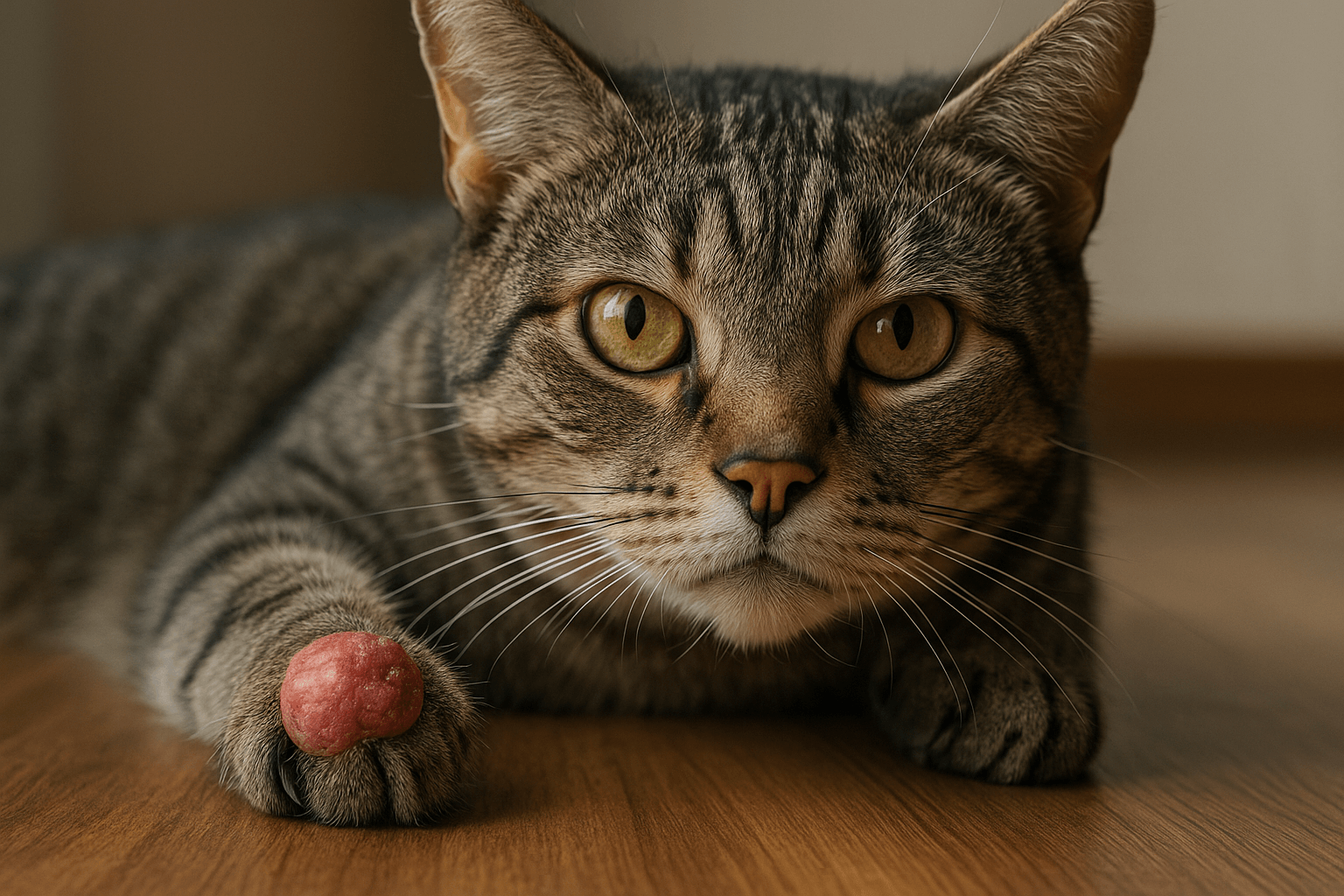Understanding Cat Skin Conditions: Causes, Symptoms, and Care
Our feline friends are known for their sleek, soft coats that make cuddling them an absolute joy. However, when your cat starts scratching excessively, losing fur, or developing red patches, it could be a sign of an underlying skin condition. Cat skin conditions are more common than you might think, and they can range from mild irritations to serious health concerns. As a responsible pet owner, understanding the causes, recognizing the symptoms, and knowing how to care for your cat’s skin is essential. In this guide, we’ll explore everything you need to know about cat skin conditions, empowering you to keep your furry companion happy and healthy.
What Triggers Skin Problems in Cats?
Skin conditions in cats can arise from a variety of factors, including allergies, infections, and parasites. Identifying the root cause is the first step toward effective treatment and relief for your cat. Here are some of the most common triggers:
Allergies :
Cats can develop allergies to food, pollen, dust mites, or household chemicals, leading to itching and irritation.Parasites :
Fleas, ticks, and mites are notorious for causing skin issues like flea allergy dermatitis or mange.Fungal Infections :
Ringworm is a common fungal infection that affects cats, causing circular patches of hair loss and scaly skin.Bacterial Infections :
Bacteria can invade damaged skin, resulting in hot spots, redness, and swelling.Hormonal Imbalances :
Conditions like hyperthyroidism or Cushing’s disease can lead to dry, flaky skin or excessive oiliness.
By understanding these potential causes, you can take proactive steps to protect your cat’s skin health. Early detection and treatment are key to preventing discomfort and complications.
How to Spot Skin Problems in Your Cat
Cats are masters at hiding discomfort, but certain signs can alert you to potential skin issues. Being observant and checking your cat’s coat and skin regularly can help you catch problems early. Here are some common symptoms to watch for:
Excessive Scratching or Licking :
Persistent grooming behavior may indicate irritation or pain.Hair Loss :
Bald patches or thinning fur can signal an underlying issue.Redness or Swelling :
Inflamed skin is often a sign of infection or allergic reaction.Scabs or Crusts :
These may form due to scratching or secondary infections.Unpleasant Odor :
A foul smell emanating from the skin can point to bacterial or yeast infections.
If you notice any of these symptoms, it’s important to consult your veterinarian promptly. Addressing skin conditions early can prevent further complications and ensure your cat stays comfortable.
Check this guide 👉How Can I Soothe My Cats Itchy Skin? Best 7 Health Tips!
Check this guide 👉Understanding Infected Skin Tags on Dogs: Best 7 Expert Tips

Preventive Measures | Treatment Options |
|---|---|
Regular grooming and brushing | Prescription medicated shampoos |
Flea prevention treatments | Antibiotics for bacterial infections |
Balanced diet rich in omega-3 fatty acids | Antifungal medications for ringworm |
Keeping bedding and environment clean | Allergy testing and management plans |
Routine vet check-ups | Topical creams or ointments for rashes |
Exploring Specific Skin Issues in Cats
There are several types of skin conditions that commonly affect cats, each with its own set of symptoms and treatment approaches. Familiarizing yourself with these conditions can help you better understand your cat’s needs. Here are some examples:
Flea Allergy Dermatitis :
Caused by an allergic reaction to flea saliva, leading to intense itching and hair loss.Ringworm :
A highly contagious fungal infection characterized by circular bald patches and scaly skin.Atopic Dermatitis :
An allergic skin condition triggered by environmental allergens like pollen or mold.Ear Mites :
Tiny parasites that cause itching, head shaking, and dark debris in the ears.Seborrhea :
A condition where the skin becomes excessively oily or dry, leading to flakiness or greasiness.
Each of these conditions requires specific care and attention. Consulting your vet will ensure your cat receives the appropriate diagnosis and treatment plan.
Proactive Steps to Keep Your Cat’s Skin Healthy
Prevention is always better than cure when it comes to cat skin conditions. By incorporating good habits into your routine, you can minimize the risk of skin problems and keep your cat feeling their best. Here are some helpful tips:
Maintain a Nutritious Diet :
Feed your cat high-quality food rich in essential nutrients for healthy skin and coat.Use Hypoallergenic Products :
Opt for gentle, fragrance-free grooming products to avoid irritating sensitive skin.Check for Parasites Regularly :
Inspect your cat’s coat for fleas, ticks, or other pests during grooming sessions.Provide Mental and Physical Stimulation :
Reduce stress-related skin issues by keeping your cat engaged and active.Keep Their Environment Clean :
Wash bedding, toys, and litter boxes frequently to eliminate allergens and bacteria.
Taking these steps can significantly reduce the likelihood of skin problems. Prevention not only keeps your cat healthier but also strengthens your bond through attentive care.
How to Bathe and Groom Your Cat Without Aggravating Skin Issues
Bathing and grooming are essential for maintaining your cat’s skin health, but they need to be done carefully, especially if your cat has a pre-existing skin condition. Improper techniques or products can worsen irritation, so it’s important to follow these tips:
Use Lukewarm Water :
Avoid hot water, as it can dry out your cat’s skin and exacerbate irritation.Choose Medicated Shampoos :
Opt for vet-recommended shampoos designed to soothe sensitive or inflamed skin.Brush Regularly :
Gentle brushing removes loose hair and prevents matting, which can trap moisture and bacteria.Keep Sessions Short :
Prolonged baths can stress your cat and strip their skin of natural oils.Dry Thoroughly :
Ensure your cat is completely dry after bathing to prevent fungal growth or infections.
Proper bathing and grooming not only keep your cat clean but also provide relief from discomfort. Always prioritize your cat’s comfort during these routines.
How Your Home Environment Impacts Your Cat’s Skin
Your cat’s surroundings play a significant role in their skin health. Certain environmental factors can either protect or harm their delicate skin. Here’s how you can create a skin-friendly environment for your feline friend:
Control Humidity Levels :
Use a humidifier to maintain optimal moisture levels, preventing dry or flaky skin.Eliminate Allergens :
Regularly vacuum and dust to remove pollen, mold spores, and other potential irritants.Avoid Harsh Chemicals :
Clean your home with pet-safe products to reduce the risk of chemical-induced allergies.Provide Sun Protection :
Limit direct sunlight exposure to prevent sunburn, especially for light-colored cats.Minimize Stressors :
Loud noises or frequent changes in routine can trigger stress-related skin issues.
By optimizing your home environment, you can help your cat maintain healthy skin and avoid unnecessary flare-ups. A little effort goes a long way in ensuring their comfort.
Supporting Skin Health Through Nutrition and Supplements
Sometimes, diet alone isn’t enough to address persistent skin issues in cats. In such cases, dietary supplements can provide additional support for their skin and coat. Here’s what you need to know about using supplements effectively:
Omega-3 Fatty Acids :
These reduce inflammation and promote a shiny, healthy coat.Vitamin E :
An antioxidant that helps repair damaged skin cells and improves elasticity.Zinc Supplements :
Zinc supports skin cell regeneration and combats dryness or flakiness.Probiotics :
Improve gut health, which can indirectly enhance skin condition by reducing allergic reactions.Consult Your Vet First :
Always seek professional advice before introducing any new supplement to your cat’s diet.
Supplements can be a valuable addition to your cat’s care regimen, but they should complement—not replace—a balanced diet. With proper guidance, you can safely boost your cat’s skin health.
Frequently Asked Questions About Cat Skin Conditions
How do I know if my cat has fleas?
Look for excessive scratching, tiny black specks (flea dirt) on the skin, or visible fleas in the fur.
Can I use human shampoo on my cat?
No, human shampoos can irritate your cat’s skin; always use products specifically designed for cats.
Is ringworm contagious to humans?
Yes, ringworm is zoonotic, meaning it can spread from cats to humans, so handle infected cats with care.
Why does my cat have dandruff?
Dandruff can result from poor nutrition, dehydration, or underlying skin conditions like seborrhea.
When should I see a vet for my cat’s skin condition?
Consult a vet if symptoms persist, worsen, or include open sores, odor, or significant hair loss.
Final Thoughts: Prioritizing Your Cat’s Skin Health
Cat skin conditions are more than just surface-level issues—they can significantly impact your pet’s quality of life. From identifying causes and recognizing symptoms to implementing preventive measures and seeking professional care, staying informed is the best way to support your cat’s well-being. Remember, a healthy coat reflects a happy and thriving feline. By giving your cat the attention and care they deserve, you can ensure they remain as vibrant and playful as ever. So, keep an eye out for any changes, trust your instincts, and don’t hesitate to reach out to your vet when needed. After all, your cat relies on you to help them feel their best!
Cuterebra Larvae in Cats: Best 7 Expert Tips! – Expert advice on signs, treatment & prevention of this rare but serious feline parasitic infestation.
Cuterebra Larvae in Dogs: Best 7 Expert Tips! – Expert advice on signs, treatment & prevention of this rare but serious parasitic infestation.
Cat Tumor on Paw: Best 7 Expert Tips! – Expert advice on signs, diagnosis, treatment & care for feline paw tumors.
Panacur Side Effects in Dogs: Best 7 Expert Tips! – Safe usage, common reactions & when to call the vet.





